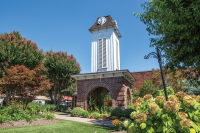Forsythia heralds the spring season
The recent warm spell has the birds singing and various plants budding. One of these is forsythia. My wife, Elizabeth, recently placed several clippings in a vase in our home, near a window, where the light and warmth will force them into early bloom. But they’ll soon be flowering in gardens and in the wild, where they have become naturalized. They are one of the few flowering plants that flourish in March, brightening dooryards, woodland edges, and stream margins with their delicate spires of yellow flowers.
A member of the Olive Family, forsythia belongs to a genus containing seven distinct species, all of which are native to eastern Asia, except for one that’s found in eastern Europe. Three of the Asian species are the ones introduced as ornamentals into Europe and this country beginning in the early 19th century. They are known by their generic name (Forsythia) and by common names like golden bells, yellow bells, and “yaller” bells.
The scientific name honors William Forsyth (1837-1804), a founding member of the Royal Horticultural Society of London. It was Forsyth, by the way, who encouraged the botanical studies of John Fraser, the Scottish botanist who explored the Southern Appalachians during the late 18th century, discovering Fraser fir, Fraser sedge, and other notable plants.
Numerous variegated, dwarf, and many-flowered horticultural varieties of forsythia were developed in the 20th century; however, three of the Asian species ae the ones you’re likely to encounter around old homesteads here in the Smokies region. If you’ve been wondering, as I have, about the kind of old-time forsythias growing on your property, it’s possible to make a reasonable determination based on various growth characteristics.
Weeping forsythia (Forsythia suspensa) was introduced into cultivation in 1833 by Philipp Siebold (1791-1866), a German physician who worked for the Dutch East India Company in Japan from 1826-1830. He later established a nursery at Leiden, where he also introduced Japanese azaleas, bamboos, camellias, hydrangeas, and lilies. Weeping forsythia grows eight feet or more high, with slender branches often bending to the ground and rooting at its tips. The flowers are bright yellow. The toothed leaves are often deeply lobed or divided into three parts. The twigs are hollow except where leaves occur.
Greenstem forsythia (Forsythia viridissima) was introduced into cultivation in 1844 by William Fortune (1813-1880), a Scottish plant collector sent to China in 1843 by the Royal Horticultural Society. In those days, the trip from China to England around the Cape of Good Hope took up to five months in salt-spray conditions that killed most exposed plants. Fortune shipped his plants home in Wardian cases, glass boxes sealed together so that no moisture escaped, with sufficient soil in the bottom of the container so that root cuttings or small plants could be grown.
Related Items
In this manner, he was able to introduce such plants as Chinese anemone, golden larch, Oriental bleeding heart, Chinese fringe tree, lacebark pine, double-file viburnum, white-flowered wisteria, old-fashioned weigela, and forsythia. Greenstem forsythia has erect, bright green branches, reaching up to 10 feet high. The flowers are greenish-yellow. Most of the lance-shaped leaves are toothed, although a few may be smooth-edged. This is the only forsythia species graced with autumn leaf color, a lovely purplish red. The pith inside the twigs is partitioned.
Korean forsythia (Forsythia ovata) was introduced into cultivation in 1919 by E.H. “Chinese” Wilson (1876-1930), an English plant collector sent to Asia on four separate occasions by the Arnold Arboretum in Cambridge, Mass. Wilson was responsible for introducing hundreds of plant species into cultivation, including regal lilies. He located a new species of forsythia in the remote Diamond Mountains of Korea. This species has proved to be the hardiest of all the forsythias, one that does well in northern New England and would prosper in the higher elevations here in the Southern Appalachians. The bright yellow flowers are smaller and not as prominent as those of the species described above. The ovate leaves clearly distinguish it from any other forsythia.
George Ellison wrote the biographical introductions for the reissues of two Appalachian classics: Horace Kephart’s Our Southern Highlanders and James Mooney’s History, Myths, and Sacred Formulas of the Cherokees. In June 2005, a selection of his Back Then columns was published by The History Press in Charleston as Mountain Passages: Natural and Cultural History of Western North Carolina and the Great Smoky Mountains. Readers can contact him at P.O. Box 1262, Bryson City, N.C., 28713, or at This email address is being protected from spambots. You need JavaScript enabled to view it..









